Don't wanna be here? Send us removal request.
Text
Fast or Forgotten? Why Mobile App Speed Will Define Your Brand in 2025
Speed is the cornerstone in 2025, not simply a perk. Users anticipate that your software will load more quickly than they can blink. They will leave negative reviews, swipe away, and go to your competitors if it lags. I want to know if your app can keep up.
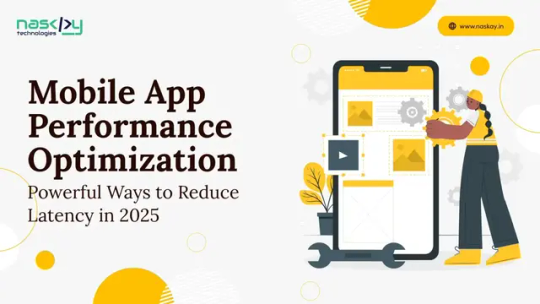
⚡ The Importance of App Speed
Retention Game: 74% of consumers who utilize quick apps remain longer.
Revenue Booster: Conversions drop by 7% after a 1-second delay.
Brand Trust: Speed fosters loyalty while lag causes churn.
🔧 6 Smart Ways to Optimize Mobile App Performance
Compress Everything: Using WebP and AVIF, which are lightweight picture and video formats.
Efficient Data Handling: Only load necessary data. Long lists should be paginate.
Optimize Codebase: Optimize your codebase by cleaning it up, removing unnecessary libraries, and minifying scripts.
Strengthen Network Performance: Use loading skeletons and background synchronization to improve network performance.
Smart UI/UX: It is not necessary to be large to be beautiful. A simpler layout results in a quicker experience.
CDNs & Edge Servers: Use the server closest to the user to load data. revolutionary in terms of worldwide reach.
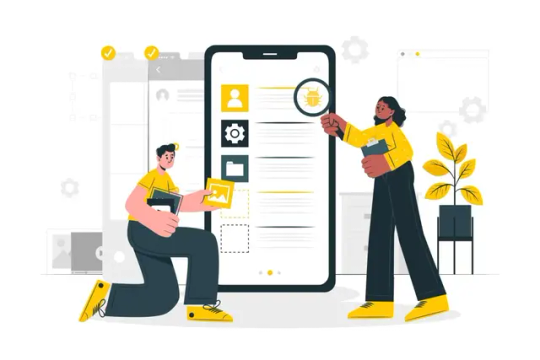
💡 The Naskay Edge
At Naskay Technologies, we know that empathy equals performance. Every touch and tap creates an emotion, and sluggish apps destroy that feeling. We assist businesses and startups in creating blazing-fast apps with scalable tech stacks, zero-lag experiences, and beautiful UI/UX.
✅ Conclusion
It's not simply technical speed. It's sentimental. Users are informed that "We value your time." Now is the moment to improve your app if it hasn't already. Your go-to partner for mobile app development is Naskay Technologies, whether you're beginning from scratch or resolving performance difficulties. Visit us at: naskay.in
Contact us now: hello@naskay,in
0 notes
Text
Why Real-Time Features & Instant Messaging Apps Are Must-Haves in 2025
Has your app ever seemed to be speaking to you? Real-time app strength is demonstrated when it rapidly responds to your question, tracks your cab, or sends a reminder.
These days, applications are more than simply tools; they are active, dynamic, and user-focused. Let's examine how real-time functionalities like push notifications, location monitoring, and in-app messaging are altering the game:
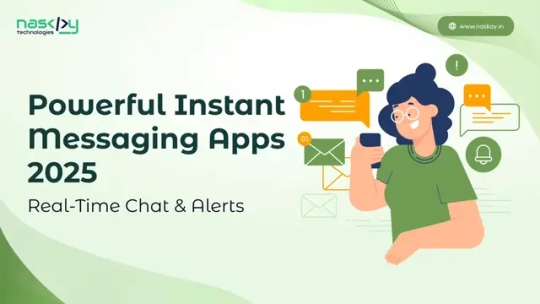
🔹 Key Real-Time Features That Matter:
1. In-App Messaging
enables users to chat within the app.
increases user retention by three times.
builds trust by responding quickly.
keeps discussions safe within your company.
2. Location Tracking
GPS-based tracking enhances transparency.
vital for ridesharing, distribution, and even medical applications.
70% of users expect it by default.
Should be privacy-first and visually clean.
3. Push Notifications
User engagement can increase by up to 88% when prompt nudges are given.
Customized alerts can increase conversions by four times.
beneficial for on-demand services, fitness, and e-commerce.
📍 Where It’s Working Already:
E-commerce: Updates on deliveries and cart reminders.
Healthcare: Tracking ambulances, doctor-patient chats.
Fintech & Banking: Transaction alerts, live support.
On-Demand Apps: Direct driver texting, ETA, and trip updates.
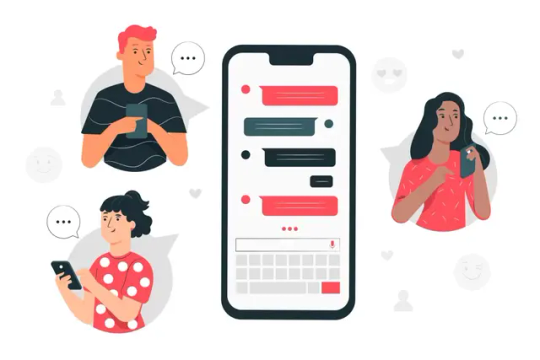
🤝 How Naskay Technologies Helps
Our specialty at Naskay Technologies is creating intelligent, responsive apps with the following tools:
✔️ Intelligent, user-focused push notification systems ✔️ Real-time GPS location tracking ✔️ Custom in-app messaging design
We assist brands with creating UI/UX and cross-platform mobile apps that users trust and utilize on a daily basis.
✅ Conclusion
These days, real-time app features are expected rather than a luxury. The time to invest in intelligent, responsive technology is now if you want your app to connect, convert, and keep users. Allow Naskay Technologies to develop your app's future, one instant in time at a time.
Visit us at: naskay.in
Contact us now: hello@naskay,in
0 notes
Text
The Fintech Revolution: Why UI/UX Is the Heart of Modern Finance Apps
Long bank lines and tiresome paperwork are things of the past. Financial services may now be accessed quickly, securely, and from your phone thanks to the growth of fintech applications. Whether it's investing, bill splitting, or balance checking, today's finance applications make money management easier than ever.

Why Fintech Apps Are Winning
Fintech apps have outpaced traditional banking due to several key factors:
Smartphone Ubiquity: Since more than 85% of American people own a smartphone, mobile-first banking is the standard.
Demand from Gen Z and Millennials: Due to their convenience and usability, 50% of younger customers increasingly favor digital-only banks.
Pandemic-Driven Growth: As banking requirements shifted to remote locations, fintech applications—which provide security and round-the-clock access—exploded.
Smart UI/UX Strategies: Personalized dashboards, clear layouts, and easy-to-follow flows foster satisfaction and trust.
High Investor Confidence: Long-term faith in digital banking platforms is demonstrated by the fact that fintech funding exceeded $75 billion in 2022.
Essential Elements of Successful Finance Apps
Dashboards with personalization to monitor spending and goals
For strong security, use 2FA and biometric login.
Easy Onboarding with Assisted Registration
All-device responsive cross-platform design
Fintech vs Traditional Banks
While banks operate on fixed hours, fintech apps offer on-demand convenience, tailored insights, and instant transaction capabilities—anytime, anywhere.
Conclusion
By putting the user first, fintech apps have completely changed the banking industry. What sets highly striking apps apart from mediocre ones is their seamless functionality and elegant UI/UX design.
Our specialty at Naskay Technologies is developing safe, effective finance solutions for both startups and large corporations. Our mission is to assist you in developing finance apps that foster growth and trust, from custom app creation to user experience best practices.
Are you prepared to create digital finance's next great thing? Your fintech journey can be guided by Naskay Technologies.
Visit us at: naskay.in
Contact us now: hello@naskay,in
0 notes
Text
Why Tourism Mobile Apps Are No Longer Optional in 2025
Traditional travel agencies are becoming outdated in today's fast-paced world, where customers seek personalized experiences and immediate assistance. Since more than 70% of tourists use smartphones to plan their journeys, mobile apps are now crucial to the travel and tourism sector.
You're losing out on income and reach if your travel agency continues to use antiquated techniques. This is where developing mobile apps for tourism comes in, transforming the way tourists plan, book, and discover.

Why Invest in a Tourism Mobile App?
✅ Smooth Bookings –With a few taps, make it easier to book hotels, flights, and activities.
✅ Itinerary Planning – This feature allows users to plan their days, discuss their travel plans with pals, and sync with calendars.
✅ Real-Time Updates – Stay informed on weather, reservations, and itinerary modifications in real time.
✅ Offline Access – Enable users to navigate itineraries and maps without internet connectivity.
✅ Customized Suggestions –Increase interaction with recommendations that are based on individual tastes.
✅ Environmental & AR Features – Use environmentally friendly choices and engaging travel experiences to stay current.
What Should App Designers Avoid?
🚫 Overzealous asks for authorization
🚫 Generic User Interface/UX
🚫 Ignoring users on several platforms
The Naskay Edge
At Naskay Technologies, we specialize in creating unique travel applications that are aesthetically pleasing, seamless to use, and incredibly user-focused. We take care of everything, from clickable prototypes to full-stack development and post-launch assistance. We provide clever mobile-first solutions to help you grow, whether you're a startup in the tourism industry or a modest U.S. travel agency.
Conclusion
Mobile-first, experience-driven, and innovation-driven travel is the way of the future. Keep your travel agency ahead of the curve. With a travel app that embodies your company, embrace the digital revolution by collaborating with a reputable tech specialist like Naskay Technologies.
0 notes
Text
Why Custom Fitness App Development is a 2025 Must-Have
Your app shouldn't close at ten in 2025, even though your gym could. Nowadays, being fit isn't about competing with influencers or gyms. It has to do with customized mobile apps that provide unique digital experiences. You're already a few steps behind if your fitness brand doesn't have one yet.

Why Custom Fitness Apps Matter:
✅ Customized Experiences Fitness platforms that are generic are no longer sufficient. Custom apps enable features for mental wellbeing, nutrition tracking, and customized exercise regimens that adapt to the objectives and interests of the user.
✅ Integration of Wearables Real-time health data collection is aided by smartwatches and fitness bands such as Fitbit, Apple Watch, or Garmin. This data can be used by custom apps to automatically modify recovery recommendations, hydration levels, and future exercises.
✅ Data-Based Understanding With insights that really matter, custom fitness applications enable organizations to collect and use data in an ethical manner to provide gamified rewards, increase retention, and foster loyalty.
✅ Future-Proof Architecture Do you intend to incorporate AI coaching, augmented reality exercises, or intelligent alerts in the future? A well-designed is scalable and prepared to expand in tandem with your goals.
✅The Expectations of Users Have Increased Users of today need a smooth user interface, quick updates, user-friendly design, and personalization. Only applications with the finest user experience (UX) can maintain their interest.
Conclusion:
Fitness now involves more than just going to the gym; it also involves how your app inspires, mentors, and encourages users on a regular basis. Your fitness company can only stand out in a crowded industry with a custom app.
Our specialty at Naskay Technologies is creating wearable-integrated, robust, and user-focused custom fitness applications. Our team assists you in designing, prototyping, and launching a product that consumers like and continue to use, regardless of whether you are a startup or an established fitness brand.
0 notes
Text
Staff Augmentation vs Managed Services: Which One Is Right for Your Business?
Businesses frequently have to make the difficult choice of whether to outsource everything through managed services or add more employees to your current team in the constantly changing digital landscape. Your app development strategy may succeed or fail based on your ability to recognize the differences.
🔍 What is Staff Augmentation?
You can engage qualified developers, designers, or tech specialists on a temporary basis without paying full-time staff by using staff augmentation. You get access to specialized skills while maintaining control.
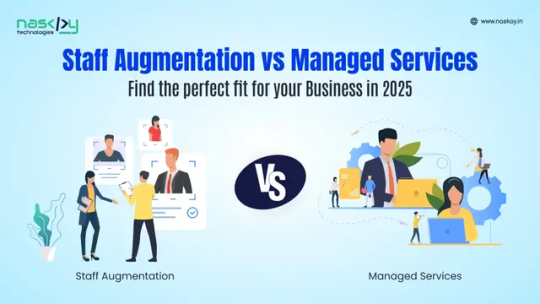
Key Benefits:
✅ Flexible scaling – Depending on the needs of the project, team sizes can be increased or decreased.
✅ Cost-effective –There are no employee benefits or overheads.
✅ Quick onboarding – Get professionals that are prepared to go right away.
✅ Total control – You have complete control over priorities, workflows, and timelines.
✅ Access to global talent – Take use of specialized expertise from any location.
💼When Should Managed Services Be Selected?
When you want to assign a single vendor to handle every aspect of a project, from planning to post-launch support, managed services are perfect.
Why Go for It?
Complete project delivery – Delegate execution and delivery to a whole team.
One-stop shop – Developers, designers, project managers, and quality assurance in one location.
Quicker time to market – Verified processes for efficiency and excellence.
Budgeting that is predictable – A set cost for specified scope and deadlines.
Continuous support – This covers maintenance, bug fixes, and updates.
🧠 Conclusion
The argument between managed services and personnel augmentation has no clear winner. If you want control and flexibility over your team, go with staff augmentation. When you require full delivery with less oversight, choose managed services.
We at Naskay Technologies assist you in selecting the best model for your company's objectives. We can help you scale your success whether you require a cross-platform app, UI/UX support, or an end-to-end solution.
Visit us at: naskay.in
Contact us now: hello@naskay,in
0 notes
Text
Accessible Healthcare Apps: The Need of the Hour
Imagine needing a medical app but being unable to use it due to a brief injury, motor impairment, or eyesight impairment. Doesn't that sound annoying? For millions of people who are excluded because of intolerant app designs, that is the terrible reality. Many healthcare apps overlook accessibility in their rush for clean design and contemporary functionality.
The Importance of Accessibility in Healthcare Apps
🔹 Health is not a privilege; it is a right. Regardless of ability, everyone should have equal access to medical care.
🔹 Inclusivity fosters loyalty User-friendly apps increase user satisfaction, retention, and trust.
🔹Ethical and legal accountability In many nations, adhering to accessibility standards like WCAG is not only advised but also mandated.
🔹Better user experience for everyone Everyone's experience is frequently more seamless when it is designed with the disabled in mind.
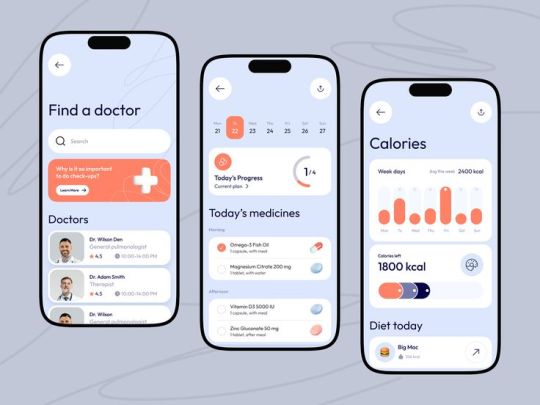
The main characteristics of accessible healthcare apps
✅ Voice navigation and compatibility with screen readers.
✅ Audio transcripts and video captions
✅ Clear, dependable, and uncluttered designs
✅ High contrast design and text size adjustment
✅ Support for external switches and keyboards
✅ No time restriction on completing the form
✅Unambiguous feedback and direction for user activities
What's Precluding the Most Apps?
Patients and platforms are at danger since more than 85% of healthcare applications don't pass basic accessibility requirements. Businesses like Naskay Technology can help with that.
The Benefits of Naskay Technology
At Naskay Technology, we create inclusive experiences rather than just healthcare apps. We make sure your app is designed for everyone, not just the tech-savvy few, by ensuring WCAG compliance and conducting practical accessibility testing.
Conclusion: Build for All, Not Just for Some
Build for Everyone, Not Just for Certain healthcare applications have the power to change people's lives, but only if they are accessible to all. Avoid making design defects an obstacle to access. Let's create inclusive, compassionate, and genuinely universal digital tools for healthcare.
Want to develop a healthcare app that is accessible to people with disabilities?
👉 Speak with Naskay Technologies right now.
Visit us at: naskay.in
Contact us now: hello@naskay,in
0 notes
Text
The Silent Power of Conversation: How Digital Healthcare is Being Reshaped by Conversational User Interface
Conversational UI is turning healthcare apps from impersonal instruments into friendly companions in a world where digital connections are ever more intimate. Consider it your virtual companion, available to help you, respond to your inquiries, and encourage your health journey in the same way that a real person would. But why is this revolution happening? Let's dissect it.

🌟 Main Points
1. Explain the conversational user interface.
Apps with conversational user interfaces can communicate verbally or through text, just like people. With the use of natural language processing (NLP), even the most complex medical data can now be explained in simple, understandable terms.
2. Chatbots' Ascent in the Medical Field
These days, chatbots are an essential component of digital healthcare. They provide prompt, accurate, and round-the-clock assistance—no lengthy calls or perplexing menus are required—for everything from scheduling appointments to assessing symptoms or responding to frequently asked questions.
Were you aware? By 2034, it is anticipated that the healthcare chatbot industry would have grown from $1.49 billion in 2025 to $10.26 billion.
3. Virtual AI Helpers: Compassionate Healthcare
Virtual health assistants, which go beyond chatbots, provide ongoing assistance with compassion and customization. These AI technologies serve as a virtual caregiver, always available when you need them, whether it's for health advice, emotional check-ins, or reminders.
🤖 Fun fact: 78% of consumers interacted with virtual assistants last year. (Salesforce, 2022)
4. Voice AI: Now Listening to Your Healthcare
Voice AI enhances the experience. Natural speech is possible for patients, and apps react in the same way that a human would. This is particularly useful for:
Older or blind users
People with learning disabilities or children
Situations in which typing is impossible
5. Mental Health Chatbots: Always There to Listen
Wysa and other AI-powered mental health chatbots assist millions of people in managing their anxiety, practicing mindfulness, and talking through their feelings without passing judgment at any time or place.
6. Other Silent Heroes
Additional Silent Heroes Symptom analysis tools that pose pertinent queries
Medication bots that maintain your well-being
Prevention trainers who promote healthy behaviors on a regular basis
✅ Conclusion: The Future Is Conversational
Conversation Is the Way of the Future People in today's fast-paced environment want to talk to apps, not just "use" them. They can, too, with conversational user interface. It infuses technology with a human element, enhancing the intelligence, accessibility, and personalization of digital healthcare.
Our specialty at Naskay Technology is creating healthcare applications that are genuinely patient-centered, not just utilitarian. We assist clients in creating digital experiences that resemble genuine interactions, from voice AI and chatbot integrations to user-friendly design.
One clever exchange at a time, let's revolutionize healthcare.
Visit us at: naskay.in
Contact us now: hello@naskay,in
0 notes
Text
The Development of Healthcare On-Demand Apps: Prospects and Developments for 2025
These days, healthcare applications are becoming a necessary component of contemporary healthcare systems rather than merely an add-on. These applications, which range from remote health monitoring to virtual consultations, are revolutionizing patient experiences and increasing access to treatment. This is how they are spearheading the transformation.
Principal Advantages of Health Apps
1. Constant Accessibility Healthcare is now genuinely on-demand since anyone can contact a doctor at any time and from any location.
2.Affordable Medical Care By reducing travel and infrastructure expenses, these apps lower the cost of high-quality healthcare.
3. Easy Access to Convenience Bid farewell to lengthy lines and scheduling difficulties. Make appointments, obtain medications, and consult experts with a few clicks.
4. Personalized, Data-Driven Care Personalized, Data-Driven Care Apps gather and examine medical information to provide more precise, customized treatment regimens.
5. Enhanced Provider Efficiency Doctors save time with digital records, automated prescriptions, and smoother patient management.
📈 Emerging Trends to Watch

AI & Predictive Healthcare: From early diagnosis through behavior and speech signals to mood detection.
RPM with wearables: Real-time vitals monitoring that is directly connected to apps.
AR/VR Diagnostics: Virtual physical examinations using immersive technology.
Blockchain for Health Data: Complete patient control over safe, transportable medical records.
⚠️ Challenges Still Exist
There are still issues with data privacy.
Digital literacy gaps
Disjointed healthcare environments
AI-related ethical issues
Conclusion Healthcare in the future will be hybrid, combining clever digital technologies with conventional treatment. Apps for healthcare are driving this change by improving access, speed, and intelligence of care. 👉 Naskay Technology leads the way in developing smart, safe, and easy-to-use healthcare apps. Together, let's create something strong if you're prepared to innovate in the field of digital health.
Visit us at: naskay.in
Contact us now: hello@naskay,in
0 notes
Text
The Future of Wearable Healthcare Devices: Making Health Smarter and More Connected
Do you recall Tony Stark's Iron Man outfit that tracked his vitals? That was fantasy, but today's wearable medical technology is bringing that kind of real-time tracking to life. Wearable technology, such as smartwatches, fitness bands, and rings, is revolutionizing modern healthcare and is no longer merely trendy. These little but mighty gadgets monitor oxygen levels, blood pressure, heart rate, sleep patterns, and even stress. However, what specific changes are they making to the healthcare industry?
🔹 Important Advantages of Wearable Medical Technology
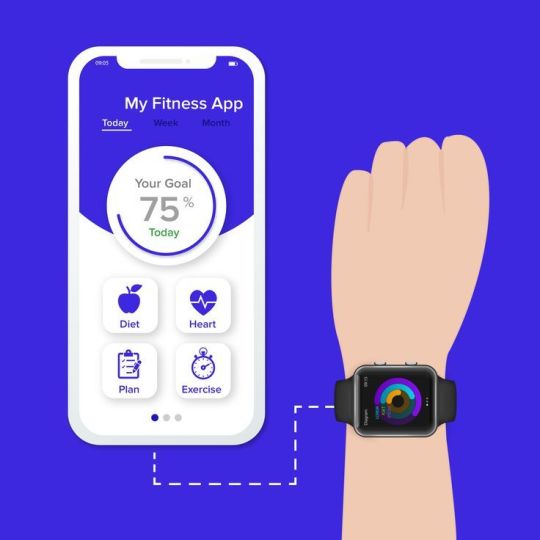
1. Health Monitoring in Real Time
Vital sign updates are instantaneous with wearables. The device can inform the user and even medical professionals for prompt action in the event of an irregular heartbeat or a fast reduction in oxygen levels.
2.Improved Control of Chronic Illnesses
Patients can monitor their metrics all day long if they have diabetes or hypertension. This aids medical professionals in decision-making, therapy modification, and problem-avoidance.
3.Monitoring Lifestyle and Fitness
Wearable technology helps users stay motivated and dedicated to their health objectives by measuring everything from nutrition and sleep patterns to step counting and workouts.
4. IoT Integration for Remote Care
The Internet of Things (IoT) enables wearable technology to connect to smartphone apps and hospital systems. Without having to visit patients in person, doctors can provide care and monitor them from a distance.
5. Personalized Healthcare
Personalized Healthcare Wearables gather comprehensive health data, enabling medical professionals to design individualized treatment programs based on individual trends and real-time insights.
Conclusion: Health That Moves With You
Our approach to health is changing as a result of wearable medical technology, which makes it more proactive, individualized, and accessible. Smart sensors, cloud storage, AI analysis, and smooth app integration have made it possible for people to carry around valuable health tools at all times. Wearable technology is becoming an increasingly important component of our daily wellness journey as we progress towards a more connected and health-conscious future. Naskay Technology will help you transform your idea into a potent digital product that keeps people engaged and healthy, whether you're trying to develop a wearable technology solution or a smart health app. Together, let's develop something creative!
Visit us at: naskay.in
Contact us now: [email protected]
0 notes
Text
The Impact of Q-Commerce on Indian Online Grocery Purchasing
Imagine this: your hunger is growling, your fridge is empty, and it is eight in the morning. Your groceries arrive within ten minutes after you immediately open an app and place your order. That is Q-commerce's (Quick Commerce) magic, and it is revolutionizing the way we shop.
Such convenience seemed unthinkable only a few years ago. However, in urban India nowadays, lightning-fast grocery deliveries are the norm because to q-commerce.
📈 Q-Commerce Trends to Be Aware of
The Q-commerce market in India is projected to grow from $3 billion in 2024 to $12 billion in 2028..
More than 8 million users each month, growing 46% annually.
There is a tremendous competition among giants like Zepto, Blinkit, and Instamart to control this market.
Social media is very important; nowadays, Instagram and WhatsApp account for 40% of Q-commerce orders.
🛒 Why Consumers Love Q-Commerce

Speed & Convenience: The reason why customers adore Q-Commerce is its speed and convenience: 10-minute delivery is now considered standard.
Dark Stores: Quicker fulfillment is guaranteed by nearby warehouses.
24/7 Access: Cravings at midnight? No issue.
Real-Time Inventory: Real-time inventory allows you to always know what's available.
User Experience: Live order tracking, seamless app navigation, and immediate assistance.
Assurance of Quality: Uncompromising fresh food.
Rewards: Rewards include subscriptions, loyalty plans, and discounts.
🚀 How to Launch Q-Commerce Apps using Naskay Technology
At Naskay Technology, we enable companies to capitalize on this rapidly evolving trend by:
Constructing cross-platform applications with lightning-fast functionality.
Creating a simple UI/UX that improves user interaction.
Ensuring that dark retailers have real-time inventory management.
Maximizing delivery, preventing fraud, and scaling smoothly with DevOps and AI tools.
🔮Concluding
Q-commerce is the future, not simply a fad. Now is the ideal moment to introduce your grocery delivery app since more customers are looking for speed and convenience. Allow Naskay Technology to collaborate with you to create a Q-commerce platform that is both high-performing and prepared for the future. Let me know if you'd like a visual structure for a post or video based on this too!
Are you prepared to embrace the revolution in Q-commerce? Together, let's create something incredible.
Visit us at: naskay.in
Contact us now: hello@naskay,in
0 notes
Text
Why Mobile Apps for E-Commerce Will Revolutionize Business in 2025
Your phone is more than just a device in today's highly digitized world; it serves as your personal shopper, assistant, and store. By 2025, 75% of e-commerce transactions will take place on mobile devices, making mobile apps imperative rather than optional.
📈 Trends in Mobile Shopping You Cannot Ignore
Global m-commerce sales is expected to reach $6.5 trillion by 2025.
Website conversion rates are 2%, whereas app conversion rates are 4%.
Apps are preferred by 54% of users over browsers.
Each session, app users view 4.2 times as many products.

🔥 Top Advantages of Ecommerce Mobile Apps
1. Enhanced Revenue
Apps make shopping easier, which boosts sales and conversion rates.
2. Improved User Experience User satisfaction is maintained through fast load times, user-friendly interfaces, and a smooth checkout process.
3. Personalized Engagement AI-powered recommendations, push alerts, and personalized purchasing experiences increase customer pleasure.
4. A more robust brand identity A well-designed app builds trust and makes your brand unforgettable.
5. Trust & Data Security Users feel protected and secure with encrypted transactions and biometric logins.
📲 AR, Voice, and 5G: The Future
E-commerce apps are developing into immersive platforms that will completely transform retail experiences, from voice-assisted purchasing and 5G-enabled speed to AR-based virtual try-ons.
Conclusion
The move to mobile is a revolution rather than a fad. Businesses must adopt mobile-first strategies with creative and user-friendly apps if they want to stay ahead of the e-commerce competition.
Naskay Technology can help with that by developing innovative e-commerce mobile apps that improve user experience, boost brands, and spur actual business growth.
👉 Are you prepared to make your e-commerce company future-proof? Join forces with Naskay Technology right now.
Visit us at: naskay.in
Contact us now: [email protected]
0 notes
Text
Mobile Applications for E-Commerce: The Future Is Already Here
Imagine looking through your phone when all of a sudden a product catches your attention. After a few taps, it will arrive at your door. That's the power of a mobile application for e-commerce: quick, simple, and immensely fulfilling. Shopping via mobile devices is becoming essential, not just a fad. Businesses who do not use mobile apps are already lagging behind, as smartphones account for more than 80% of retail traffic.
Why E-commerce Apps Are Taking Over
1. Smooth User Experience
Why Smooth User Experience Is Being Replaced by E-commerce Apps
No more repeatedly logging in or inputting URLs. Mobile apps provide smooth, customized experiences that captivate consumers. Improved Performance Websites take longer to load than apps. As a result, there will be more completed purchases and fewer cart abandonments.
2. Engagement in Real Time
Push notifications increase conversions with little effort by informing consumers about sales, discounts, and purchase updates.
3. Programs for Customer Loyalty
As seen by Amazon and Flipkart, reward points, discounts, and special offers keep customers coming back for more.
4. Safe and Simple Transactions
Mobile apps that enable a variety of payment methods, including wallets, COD, and UPI, make transactions simple and secure.
5. 24/7 Chat Assistance
AI chatbots make sure assistance is always available by tracking orders, providing fast problem-solving, and answering questions.

Technology The Secret to the Magic
While Android Studio and Flutter manage the coding, programs like Figma and Adobe XD guarantee beautiful design. Indeed, intelligent analytics systems track user behavior so that companies may continuously improve.
⚡The Development of Fast Trade
With promises of 10-minute deliveries for necessities, apps like Zepto and Blinkit are revolutionizing speed. By 2025, this speedy commerce model is expected to develop ten times faster than traditional e-commerce, according to RedSeer!
🔚 Final Thought: Using Naskay Technology to Drive the Future of Mobile Commerce
Mobile applications for e-commerce are now essential to modern company and are no longer a luxury. Their lightning-fast deliveries and easy shopping experiences have completely changed the way that customers engage with brands. Building effective, user-focused e-commerce mobile applications that assist companies in growing, interacting with, and retaining their audience is our area of expertise at Naskay Technologies. Our knowledgeable staff uses the newest tools, frameworks, and trends to craft flawless online shopping experiences that really stand out, regardless of your brand's size. Are you prepared to lead the future of commerce by focusing on mobile first? Allow Naskay Technology to transform your idea into a robust, expandable application. Visit us at: naskay.in Contact us now: hello@naskay,in
0 notes
Text
5G in 2025: Will It Help or Hurt the Development of Mobile Apps?
Welcome to the fifth generation of cellular communication, or 5G technology, a futuristic era when connectivity is redefined by incredibly rapid response times and low latency. The days of incessant buffering and lagging servers are over. 5G is changing businesses and altering possibilities; it is no longer just the future.
Key Facts About 5G
Global economic production has increased by $13.1 trillion as a result of 5G.
By 2025, the GSM Association anticipates that there will be more than 1.7 billion 5G users globally.
More than 2.8 billion users (about 35% of the world's population) will be utilizing 5G by the end of 2025.
In 2025, more than 80% of��newly released smartphones will support 5G.
50% of businesses worldwide are utilizing 5G for mobile apps, AI automation, and the Internet of Things.
The Evolution of Cellular Technology
Cellular technology has advanced significantly with each generation:
1G: Voice communication via analog.
2G: Text messaging and digital voice.
3G: Internet access on the go.
4G: Fast internet and streaming video.
5G: Massive connectivity, low latency, and extremely high speeds.
By 2025, there will likely be 75.44 billion connected devices worldwide, and 5G is driving innovation in every industry.

The 5G Advantage: Breaking Barriers
1. Unmatched Velocity
10–20 Mbps download speeds as opposed to 4G's 1 Mbps.
Smooth internet gaming, quick downloads, and instant UHD streaming.
2. Exceptionally Low Latency
Essential for AI-driven apps, remote surgery, and driverless cars.
Down to 1 millisecond (ms), guaranteeing almost immediate reactions.
3. Transmission in Multiple Spectrums
Provides wider coverage by using millimeter waves (24–100 GHz).
Permits communication in rural, suburban, and urban settings.
4. Large Capacity Network
One million gadgets per square kilometer can be connected.
Enables smooth enterprise applications, AI automation, and the Internet of Things (IoT).
5. Enhanced Efficiency and Accuracy
Increased effectiveness in AI, automation, and real-time analytics applications.
Three Foundations for Innovation in 5G
1. eMBB, or enhanced mobile broadband uninterrupted streaming in 4K and 8K. lag-free, fluid multiplayer gameplay. Real-time entertainment and games on the cloud. 2. Critical Communications for the Mission For safe navigation, autonomous cars depend on real-time data exchanges. Robotic technology has made it possible to perform remote surgery. 3. Widespread IoT Integration Wearable technology, smart homes, and industrial IoT applications. AI-powered infrastructure and traffic monitoring is being used in smart cities. Precision farming through the use of sensors and drones in agriculture IoT. mobile banking that offers smooth digital transactions and increased security.
Mobile Apps and 5G: A Potent Pair
5G has a significant impact on mobile apps and is bringing us a new era of opportunities.
Integration of AI and Machine Learning
By 2025, mobile apps will use 30% more AI and ML (Gartner).
Cloud-Based Applications
By 2025, cloud computing will account for 80% of mobile data traffic (Cisco).
Unification of AR and VR
According to Deloitte, 50% of developers are using AR and VR in real-time apps.
Scalability in the Future
According to McKinsey, 70% of multinational corporations see 5G as a key component of mobile ecosystems.
IoT App Improvement
Globally, 5G will link 1.5 billion IoT devices (GSMA).
Obstacles and Things to Think About
Despite its revolutionary potential, 5G has drawbacks.
1. A lower capacity for penetration
More base stations are needed for wide coverage.
Infrastructure optimization is required, and setup expenses are high.
2. Increased Data Consumption
Higher Data Consumption Battery life is impacted by this, as it uses 3.5 times as much power as 4G.
3. Privacy and Security Concerns
60% of customers are concerned about 5G data security (Deloitte).
increased vulnerability to cyberattacks as a result of increased network access.
4. Better Testing
Hardware compatible with 5G and extensive testing are necessary to meet high performance expectations.
5G in Mobile App Development: The Future of Innovation
With the widespread use of digitization, 5G offers mobile apps previously unheard-of possibilities. Companies can use it to create immersive experiences, high-performance apps, and more intelligent networking.
1. Slicing networks
Permits specialized mobile apps to have their own network lanes.
Extremely high speeds are necessary for gaming apps.
IoT apps for smart homes put efficiency and dependability first.
2. Edge Computing
Edge computing reduces latency by enabling real-time data transport via local servers.
Essential for sectors like healthcare and banking that require fast decision-making.
3. Tactile Internet
Without requiring physical contact, the tactile internet improves real-time system engagement.
Vital for industrial automation and robotic surgery.
The 5G Future is Here!
5G is the unseen foundation of digital revolution, affecting every organization, industry, and individual's life. Despite the difficulties, solutions are already being developed. How you plan to use 5G is more important than whether you're prepared for it. Use Naskay Technology to Transform Your Mobile Application With a focus on developing mobile apps driven by 5G, Naskay Technologies guarantees state-of-the-art innovation, improved performance, and seamless connectivity. We can help you with immersive AR/VR applications, IoT optimization, or AI integration! At Naskay, begin transforming your 5G mobile app right now!
Visit us at: naskay.in
Contact us now: [email protected]
0 notes
Text
Unfolding the Future: The Promise and Challenges of Foldable Smartphones
Mobile phone development has fully circled back to the flip-style phones of the past, but with a modern twist. With its flexible screens, cutting-edge technology, and distinctive designs, foldable smartphones are creating a stir. However, are they only a passing fad or are they here to stay?
Foldable Smartphones: A Modern Marvel
Smartphones that fold provide unprecedented versatility. These devices offer a combination of portability and an immersive user experience because to their cutting-edge OLED panels that bend flawlessly. They are mostly divided into two groups:
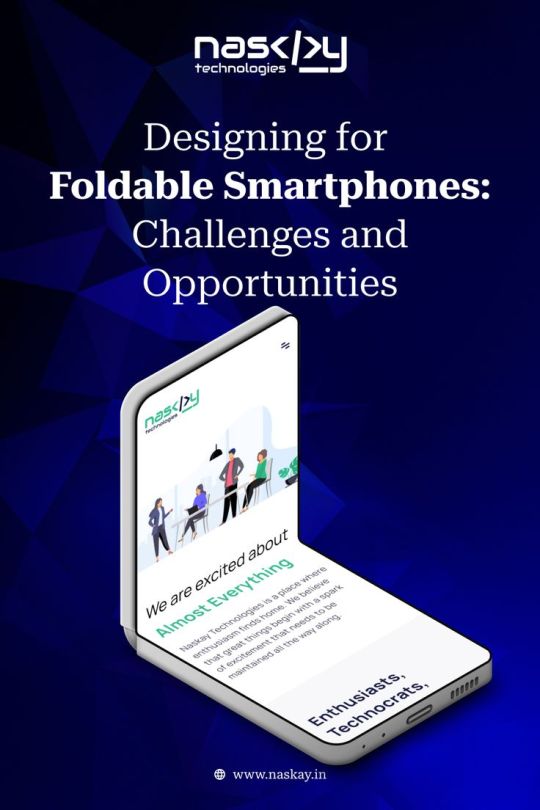
Clamshell ‘Flip’ Phones – These are little, fashionable phones that look like flip phones but have touchscreens. Motorola's Razr+ and Samsung's Z Flip are two examples.
Book-Style ‘Fold’ Phones – Phones that "fold" like books These provide a two-in-one experience by switching from a smartphone to a tablet. This design is on display in the Google Pixel Fold and Samsung Z Fold.
Why Are Foldables Gaining Popularity?
Portability –Flip phones are easy to carry because they fold up into a smaller size.
Multitasking –Bigger screens improve efficiency by providing a smooth transition between work and play.
Novelty –These gadgets are distinctive due to their special folding mechanism.
Cross-App Continuity –Usability is enhanced by seamless fold-to-unfold transitions.
Challenges and Limitations
Despite their popularity, foldable cellphones have certain drawbacks.
High Costs – Due to their premium pricing, the typical consumer cannot afford them.
Durability Concerns – Long-term dependability is called into question by the folding process.
Bulkiness – Compared to conventional phones, foldable phones are larger and heavier.
Visible Crease & Screen Distortion – Unwanted creases and uneven display quality are common outcomes of folding screens.
Battery Drain – Longer battery life is impacted by larger screens' higher power requirements.
Future of Foldable Smartphones
Foldable smartphones are expected to rise rapidly, according to market trends, with North America catching up and Asia-Pacific leading in sales. Whether these devices become widely used or stay in the luxury market will depend on developments in hinge technology, price, and durability. Foldable smartphones are on an exciting journey as companies like Samsung, Oppo, and Huawei push the envelope. One thing is for sure—the future of cellphones is developing in no
vel and fascinating ways, regardless of whether they completely transform the market or continue to be an exclusive invention!
Conclusion:
Foldable smartphones, which combine modern technology with nostalgia, mark a significant advancement in mobile innovation. Although their improved functionality and svelte designs present a novel approach to smartphone usability, issues with affordability, robustness, and usefulness prevent mainstream adoption. Foldables could soon become more dependable and accessible as manufacturers improve the technology, which could change the smartphone market. One thing is certain: foldable smartphones are ushering in a new era of mobile technology, regardless of whether they continue to be a niche luxury or develop into necessities.
Visit us: naskay.in
Contact us now: [email protected]
0 notes
Text
The Digital Revolution in Mental Health: How Therapy Apps Are Changing Lives
Did you know that 1 in 8 individuals globally suffer from a mental illness? Even though mental health problems are becoming more common, only 30–40% of people who are impacted get professional assistance. Financial limitations, accessibility issues, and the stigma associated with mental health frequently keep people from receiving the help they require. However, therapy and counseling are now more accessible than ever thanks to the growth of mental health applications.
The Rising Mental Health Crisis
The highest rates of suicide are found in Eastern Europe and Central Asia, making it the fourth most common cause of death globally. The following are the root reasons of declining mental health. Academic Pressure: Students experience stress and anxiety as a result of the tremendous pressure to perform well on competitive tests. Financial Difficulties: Growing debt and unstable economies both lead to more mental anguish. Relationship Problems: Family disputes, divorces, and social exclusion lead to emotional upheaval. Future Uncertainty: Anxiety and mental fatigue are brought on by societal shifts and career insecurity. Social Media Influence: Cyberbullying and unrealistic comparisons cause unhappiness and low self-esteem.
The Development of Apps for Mental Health
Technology has stepped in to help close the gap between people and mental health support as a result of growing global awareness. Apps for mental health provide users all around the world with immediate, affordable, and stigma-free support. The market for mental health apps was estimated to be worth $7.48 billion in 2024 and is expected to expand at a 14.6% compound annual growth rate (CAGR) between 2025 and 2030. Nearly 40% of Americans experienced worry, anxiety, or depression during the COVID-19 epidemic, which further expedited this digital change.
Benefits of Apps for Mental Health
Numerous advantages offered by mental health applications increase the accessibility and inclusivity of therapy:
Breaking Barriers: They connect with people in isolated areas with limited access to mental health treatments.
Cost-effective: Compared to in-person consultations, online therapy sessions are substantially less expensive.
Anonymity: People can ask for assistance without worrying about shame or condemnation.
24/7 Accessibility: Immediate access to self-care resources, AI-powered therapy, and expert assistance.
Community Involvement: Peer forums and support groups offer a secure environment for healing and sharing of experiences.

Must-Have Features in Mental Health Apps
The following elements must be included in a mental health app for it to be successful:
Virtual Therapy Sessions: Using teletherapy to close the distance between patients and mental health providers.AI Chatbot Support: AI-driven chatbots offer guided therapy sessions and immediate emotional support.Analytics & Mood Tracking: Users can track their development and spot trends in their behavior.Push Notifications & Reminders: Promoting regular wellness routines and therapy sessions.Gamification and Rewards: Using interactive tasks and rewards to increase participation.Programs for Personalized Therapy: Tailored approaches to particular mental health issues.
AI, Virtual Reality, and Gamification in the Future of Therapy Virtual reality, gamification, and artificial intelligence innovations are revolutionizing mental health care:
AI Chatbots: Sophisticated NLP-driven chatbots offer individualized, real-time therapy.
VR Therapy: In a safe setting, virtual exposure therapy helps people confront their phobias.
Gamification: Interactive tasks and incentive schemes improve therapy outcomes and user retention.
Conclusion: Is Digital Therapy the Way of the Future?
Apps for mental health can be a useful addition to offline therapies, but they cannot completely replace traditional therapy. The long-term viability of digital therapeutic platforms depends on finding creative answers to issues including user engagement, data privacy, and efficacy. 🚀 Create innovative mental health apps and transform digital therapeutic solutions by collaborating with Naskay Technology. Together, let's influence the direction of mental health in the future!
Visit us at: naskay.in
Contact us now: [email protected]
0 notes
Text
Gamification in Healthcare Apps: A Game-Changer for Patient Engagement in 2025
You have that recurring twinge of remorse after forgetting to take your daily medication due to your hectic schedule. Does that sound familiar? Adhering to a health routine is difficult, let's face it. Frequently, it seems like a chore. However, what if taking care of your health were more like advancing in your preferred game? That is now a reality because of gamification. Healthcare apps that incorporate game-like elements provide users the same dopamine surges that come from engaging in enjoyable, rewarding games. Patients, healthcare professionals, and IT businesses all benefit from it. Let's see how gamification is changing the medical field.
What is healthcare gamification?

In order to improve user engagement and promote constructive behavioral changes, gamification entails incorporating game-like aspects into non-gaming contexts, such healthcare applications. These components support condition monitoring, fitness advancement, long-term therapy objectives, and more. Since gamification has its roots in behavioral psychology, it is an essential part of contemporary healthcare applications.
The Daily Login Rewards feature is a crucial gamified component of healthcare apps that promotes habit building, user loyalty, and enhanced engagement. A sense of success is fostered and milestones are acknowledged with achievement badges and trophies. Experience (XP) points and progress bars are used in progress tracking to reward user efforts. Random Rewards: Using unforeseen incentives, this feature adds excitement and inspires users.
The Expanding Gamification Trend
Growth Throughout History Present-Day Patterns Prospects for the Future According to Marketsand Markets, the global gamification industry is worth $9.1 billion in 2022.$22.2 billion is the market value in 2024 (Source: Imarc Group).Growth of $30.7 billion at a CAGR of 27.4% is anticipated by 2025 (Source: Marketsand Markets). According to Allied Market Research, the global healthcare gamification market is worth $3.3 billion in 2021.According to Sky Quest, the market will be worth $4.37 billion in 2023.Growth is anticipated to reach $8.6 billion by 2031 at a CAGR of 10.98% (Source: Straits Research).
The Psychology Behind Gamification
B.F. Skinner's operant conditioning—more especially, positive reinforcement—is the foundation of gamification. Users get badges, XP points, and rewards for completing desired tasks, such taking their prescription on time or participating in fitness contests. By encouraging ongoing participation, this positive feedback loop transforms healthcare duties from chores into pleasurable hobbies.
Gamification's advantages in healthcare include
1. Enhanced motivation
Because gamified components make progress feel pleasant, they increase intrinsic motivation and encourage patients to stick to their health goals.
2.Interaction with Others
Peer challenges and leaderboards are examples of features that increase patient engagement by fostering a sense of support and community.
3.The ability to scale
Diabetes control, mental health treatment, rehabilitation, and medication adherence are just a few of the healthcare domains where gamification is applicable.
4.Establishment of Habits
Over time, reward incentives and daily login streaks assist patients in forming and sustaining healthy habits.
5. Improved Comfort for Patients
Better analytics and insights result from consumers feeling more at ease sharing private health information through interactive and entertaining healthcare apps.
Prominent Apps for Gamified Healthcare
Kaia Health – Promotes breathing techniques and awareness, offering incentives for advancement.
Mango Health –Provides daily incentives to help customers follow their drug regimens.
Habitica – Reinforces healthy routines by transforming everyday health tasks into quests.
SuperBetter –Transforms obstacles into fun activities through gamification to promote mental health.
Best Practices for Creating a Gamified Healthcare App
Our specialty at Naskay Technologies is creating gamified, entertaining healthcare applications. This is how we guarantee success:
User-centric UI/UX design – Ensuring a seamless, intuitive experience for all users.
Integration of AI and Machine Learning –Tailoring tasks according to user aptitude and development.
Cloud Backend Support –Real-time leaderboard changes and data syncing are made possible with cloud backend support.
Blockchain-enabled rewards –Guaranteeing openness and preventing fraud in the distribution of rewards.
Scalable Microservices Architecture - Enables challenges and content to grow dynamically.
Cross-Platform Compatibility – Creating applications that function flawlessly on the web, iOS, and Android platforms is known as cross-platform compatibility.
Successful Engagement Techniques for Healthcare Apps with Gamification
Customized Exchanges – For greater impact, adjust objectives and challenges to the needs of each patient.
Adaptive Difficulty Levels – To prevent stagnation and encourage advancement, gradually raise the level of complexity.
Community and Social Sharing – Make it possible for people to interact, compete, and work together.
Progress Visualization –To inspire others, highlight accomplishments with vibrant animations and benchmarks.
What Comes Next? Future Directions for Gamified Healthcare
1. Experiences with AR and VR in Healthcare - AR-led physiotherapy or VR-assisted rehabilitation transforms recuperation into immersive experiences.
Stat: By 2026, the VR healthcare market is anticipated to grow to $7 billion. (Research Grand View)
2. Personalization Driven by AI - Gamification that dynamically adjusts to progress, lifestyle, and health objectives.
Stat: AI personalization is already used by 70% of healthcare firms. (Accenture)
3. Gamification of Social Media - Wellness and fitness issues Missions with friends encourage joy and responsibility.
Stat: 60% more people use social gamified apps. (Alert)
4. Tokens Powered by Blockchain - Real benefits and impenetrable reward systems ensure steady participation.
Stat: By 2026, blockchain-based gamification is expected to generate $1.7 billion. (Markets and Markets)
Let's Conclude
Gamification is a game-changing technique that can improve healthcare outcomes, boost engagement, and make treatment regimens less intimidating. It's not just a fad. Now is the perfect moment to develop a gamified healthcare app. Allow your app to provide more than just functionality; allow it to provide enjoyment, inspiration, and significant advancement.
Get in touch with Naskay Technologies right now to realize your idea for a gamified medical software!
Visit us at: naskay.in
Contact us now: [email protected]
0 notes